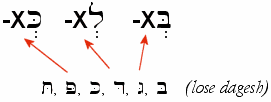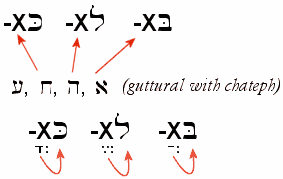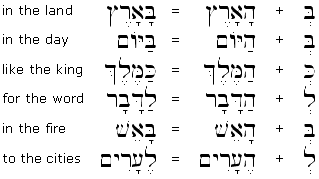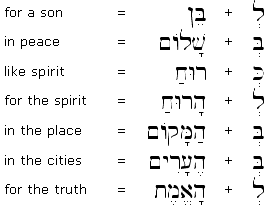|
Prepositional Prefixes
Like the definite article Hey and the conjunctive Vav, three additional letters can function as a prefixes to Hebrew words. These are Bet (meaning "in," "on," or "by"), Kaf (meaning "like," or "as"), and Lamed (meaning "to," or "for"). These prefixes are sometimes called "inseparable" prepositions because they cannot stand alone as independent prepositions.
In Hebrew, you may add one of these prefixes before a noun to indicate that the noun is the object of a prepositional relationship. For example, the word melekh simply means "king," but the word lemelekh means "for a king" (note how the prefix immediately renders the noun as the object of the preposition).
Sometimes the vowel under the prefix will change, depending on the consonant that appears at the beginning of the word. Many of the vowel changes you will see here correspond with those of the Conjunctive Vav prefix you studied in Unit 4.7.
CASE 1: The Basic Form

These prefixes normally join to their objecct using the Sheva:

In each of these cases, the prefix (with the Sheva) is simply appended to the word to form the prepositional phrase. No vowel changes or other spelling changes occur.
CASE 2: Before Begedkephat Letters
When these prefixes precede the Begedkephat letters, they lose their dagesh lene.

Every time a Begedkephat letter begins a word, it takes a dagesh lene. But when a prefix is added, however, such a letter will lose its dagesh (since it no longer begins the word). For example:

(Note that the second example (livrit) undergoes a vowel change that will be explained in Case 3, below.)
CASE 3: Before Letters with Sheva
The first rule of Sheva states that two shevas at the start of word result in Chireq in a closed syllable:

When we add a prepositional prefix to a word that begins with a Sheva, the prefix therefore takes a Chireq vowel:

For example:

Exception: If the word begins with Yod, the Sheva is dropped altogether:

CASE 4: Before Guttural Letters
If a prefix is joined to a guttural letter having a compound sheva, the prefix takes the simple form of the vowel:

For example:

Notice how the Chateph Segol of the Aleph (in emet) transfers its corresponding unreduced form (Segol) to the Bet, and how the Chateph Patach (in ari) transfers its unreduced Patach to the Kaf. You should be able to understand the transference for the last example, choli.
Since Chateph ("reduced") vowels are a form of vocal Sheva, you can see that by adding an inseparable preposition you would have two vocal shevas in a row -- which is forbidden in Hebrew. This vocalic transfer is sometimes called the Second Rule of Sheva.
CASE 5: Before the Definite Article Hey
Finally, if a prefix is joined to a noun with the definite article, a contraction occurs: the Hey drops out and the prepositional prefix takes the vowel that was under the Hey:

Examples:

In each of these cases, notice how the Hey prefix of the definite noun drops and is replaced with the prepositional prefix.
Section Exercises
- Memorize the section vocabulary (top of the page)
- Determine the result of adding the following prefixes to the nouns:

- Using your lexicon (and vocabulary you already know), append the three inseparable prepositions to both definite and indefinite nouns.
<< Return
|



